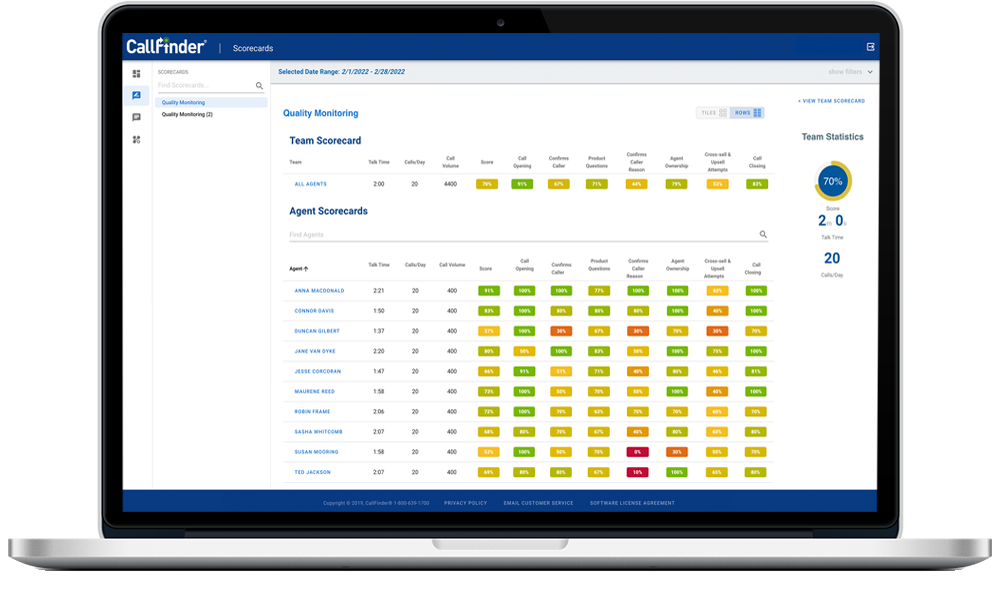Address
38 Eastwood Drive, Suite 401
South Burlington, VT 05403
Work Hours
Monday to Friday | 8AM—5:30PM EST


If you work in sales, you know the more data you have about a lead increases the value of that lead and the chances it will convert to a sale. You also know that it’s crucial for sales leaders to track advertising campaigns to improve marketing strategies and guarantee the best return on investment. Most likely, then, you know that exceeding customer expectations ultimately leads to more upsell and cross-sell opportunities.
But what you may not know is that tracking the results of your advertising campaigns should be intuitive, easily accessible, and provide valuable insights into customer needs, agent performance, and revenue growth opportunities. The right call analytics tool offers all of that and ultimately helps sales managers assess performance against industry benchmarks, identify agent knowledge gaps, and create strategies based on data you can actually use.
Simply put, call analytics involves collecting data from recorded calls to improve any aspect of a business. This includes sales, marketing, customer service, and any other department that can benefit from analyzing customer calls. The technology behind call analytics makes it possible to automate key elements of call tracking and reporting. Because of this, call analytics is also a vital part of quality assurance programs.
That being said, a conversation intelligence solution should include much more than plain text transcriptions. It should also present the call analytics data with insightful summaries after. For instance, 800response and CallFinder offer automated speech-to-text transcriptions, which you can use to locate specific keywords and sales terms during calls or to identify trends specific to your sales training needs.
The tool should offer a visual presentation of the data in easy-to-interpret dashboards and reports that can be shared across all departments. For this reason, call analytics data should be comprehensive.
Call monitoring should be your first step to improving sales calls. In fact, your business most likely records calls for quality assurance since this is now a common practice and a great strategy for enhancing the customer experience. The problem is that most companies never do anything with these recordings. This is a waste of valuable data, especially if the goal is to improve customer interactions.
However, there’s so much more you can do with the information you get from recorded calls. You can use call quality monitoring to improve marketing strategies, business processes, your products and services, and yes, to close more sales. Using the insights from recorded calls, you can train agents on any number of skills, including soft skills, to help them succeed while increasing efficiency and productivity.
How do you know how your agents handle pricing conversations if you’re not analyzing them for key pricing terms? The short answer is you don’t. For example, do you know how many times the word “pricing” is mentioned, either by the agent or the caller? Even if you have a ballpark number, what do you do with that information?
Start with the language your sales team uses during calls. An automated speech-to-text tool makes this easy. Look for certain keywords to see where you’re at first.
While you may have objection crushers built into your sales scripts, you won’t know how effective they are until you hear why prospects are turning your agents down in the first place. The right solution will provide you with the ability to quickly find customer objections within the call transcriptions.
For instance, in the screenshot taken from a demo of CallFinder’s solution, you can see that this company segmented calls into 3 types of common objections: “Don’t call me again,” “No time,” and “Too expensive.”


As you can see, there were 267 calls that included the phrase “too expensive” in the call. This tells the Sales Manager that this is the most common objection used in calls for the time period selected. Given that information, the manager can update the call scripts to include more objection crushers for that particular phrase.
Using the example above, you can also dig into all the calls that mention “too expensive” and compare the agents on those calls. In the screenshot below, you can see that Duncan Gilbert has the most calls in this time frame.


CallFinder lets you easily search the transcriptions of those calls to see where the objection occurred, and how the agent handled it. Did Duncan mention a promo to ease the cost concerns? Did he offer to speak to a manager about special pricing offers? What worked, and what didn’t work?
If you know what worked for Duncan, you can add his objection crushers to the script, along with anything else he said or did to bring the prospect back to the conversation. Using successful agents as material for training guides and scripts is the best way to ensure success across all agents and agent teams.
Here are some other quick tips that you could extract from pricing conversations with prospects.


Most call analytics solutions include scorecards. CallFinder’s scorecards offer an easy way for managers to score agents on specific pricing language. You can compare agents on how they used the language, and even use scorecards to motivate agents to improve call outcomes and close deals. Ultimately, when it’s time to negotiate pricing during a conversation, your sales agents should know exactly what to do.
With 800response and CallFinder, you can easily use insights from your calls to enhance sales training, improve customer service, and close more deals. Request a demo of our call analytics solution, and learn how to close more deals!